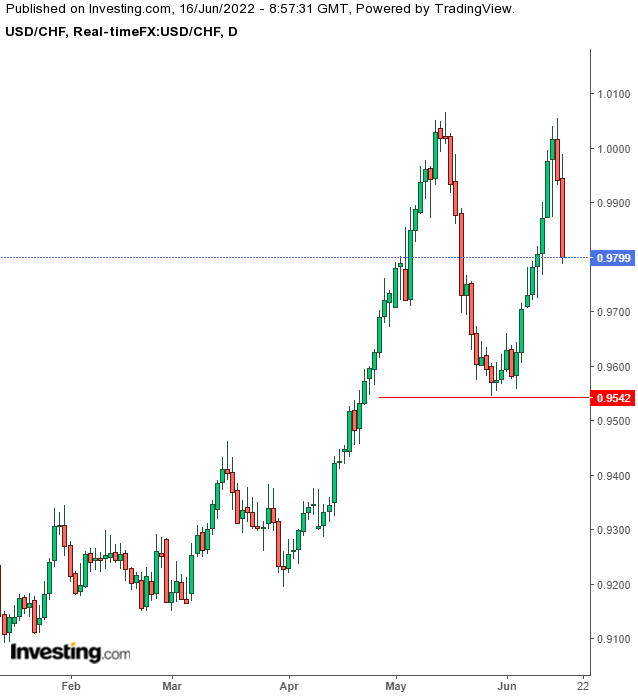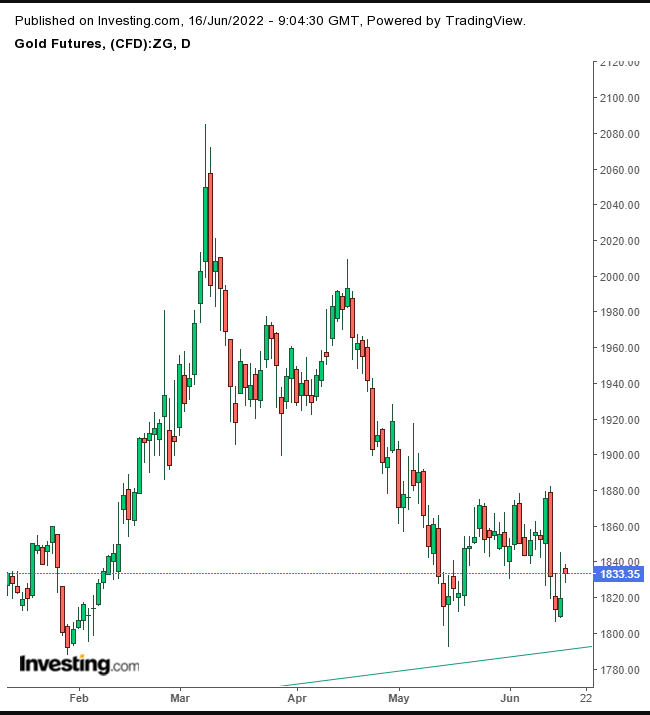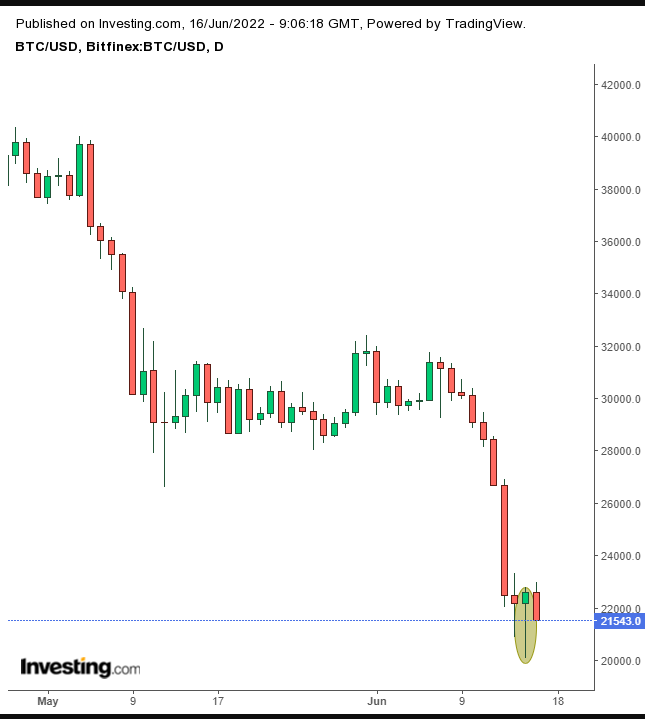- Market narrative takes a U-turn
- Surprise Swiss rate hike adds to market tensions
- Treasuries slide
- On Friday the Bank of Japan announces its interest rate decision.
- Eurozone CPI data is released on Friday.
- Federal Reserve Chair, Jerome Powell is due to speak on Friday.
- The MSCI Asia Pacific Index fell 0.5%
- The MSCI Emerging Markets Index fell 1%
- The euro fell 0.5% to $1.0393
- The Japanese yen fell 0.3% to 134.27 per dollar
- The offshore yuan rose 0.8% to 6.7180 per dollar
- The British pound fell 0.9% to $1.2066
- Germany's 10-year yield rose ten basis points to 1.81%
- Britain's 10-year yield gained five basis points to 2.61%
- Brent crude fell 1% to $117.21 a barrel
- Spot gold fell 0.8% to $1,819.94 an ounce
Key Events
The market sell-off resumed on Thursday with futures on the Dow Jones, S&P 500, NASDAQ 100, and Russell 2000 moving back into negative territory, along with European stocks.
US indices rallied yesterday following the 75 basis point hike in US interest rates by the FOMC. However, a change in sentiment this morning, perhaps spurred to some degree by today's rate hike shocker from the Swiss National Bank, which took markets completely by surprise when it announced a 50 basis point interest rate hike—the first hike of any kind for the SNB in 15 years—exacerbated concerns about future global economic growth. The Bank of England hiked rates 0.25% as expected.
Bitcoin remains under pressure and continues to trade lower.
Global Financial Affairs
All four US index futures were deep in the red notwithstanding the view expressed yesterday by many that the Fed's 0.75% increase in interest rates—the sharpest uptick since 1994—illustrates that the US central bank believes the economy will not move into recession, even with higher borrowing costs.
Traders had priced in such a steep increase—with some even betting on a 1% lift—so the markets were calm immediately after the announcement. That may be a result of US Fed Chair Jerome Powell saying such large hikes would not be the bank's standard practice.
All four major US indices jumped at least 1% yesterday during the Wall Street session. The tech-heavy NASDAQ 100 outperformed with a 2.5% surge—after the decision was published.
In Europe, the STOXX 600 Index opened lower today. While the pan-European gauge broke a six-day losing streak after rallying on Wednesday, it did so before the Fed interest rate decision. Thus we're not seeing the same fickleness in Europe as we do in US trading.
Of course, we could allow for the possibility that today's futures have been sold off by foreign traders while US traders are more optimistic, which will manifest in trading when the market opens in New York.

The European index price is holding just above the March lows. If the price falls below 405.61, it will have extended the short-term downtrend, as it establishes a long-term downtrend.
The UK's FTSE 100 opened lower and is trading at its weakest since Mar. 11.
After the Swiss National Bank rate decision, investor worries increased. The Swiss franc, considered a classic safe haven, soared.

The USD/CHF moved lower from near its high in May 2019. A fall below 0.95 for the pair would complete a Double Top.
Earlier today, Asian stocks were mixed. Many regional indices wiped out the post-Fed relief rally on fears that inflation will continue to increase. Hong Kong's Hang Seng dropped 2.17%, leading the decline while China's Shanghai Composite fell 0.6%. Japan's Nikkei 225 outperformed with a 0.4% gain.
Yesterday's US stock rally ironically ended a five-day decline, which had scraped 10% off the S&P 500 Index.
Renewed concerns about the impact of monetary tightening on economic output and asset valuations sparked a rout in Treasuries, including the 10-year note. That sent the dollar up for the sixth time in seven days.
Gold jumped despite dollar strength, perhaps confirming Wednesday's Inverted Hammer.

The uptrend continues to support the yellow metal's price.
Bitcoin is down, testing yesterday's hammer, which upended an eight-day losing streak.

We expect a Dead Cat Bounce before the price continues lower, along with the long-term downtrend.
Oil fell for the third straight day, to a two-week low, after attempting to rally.
